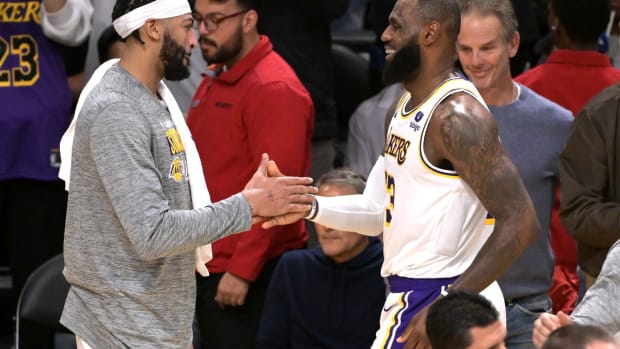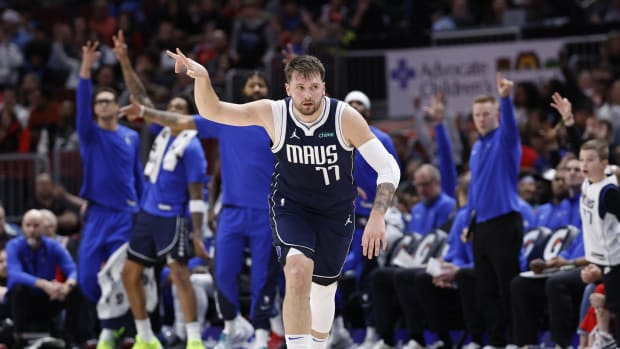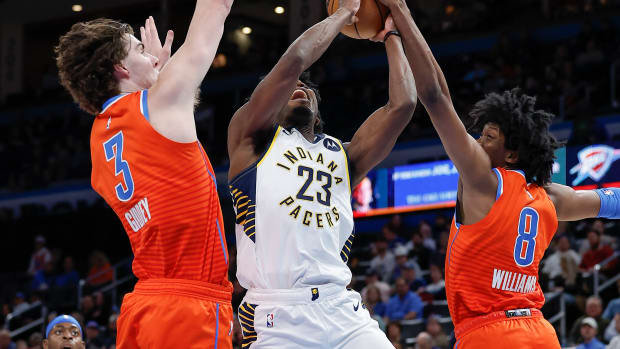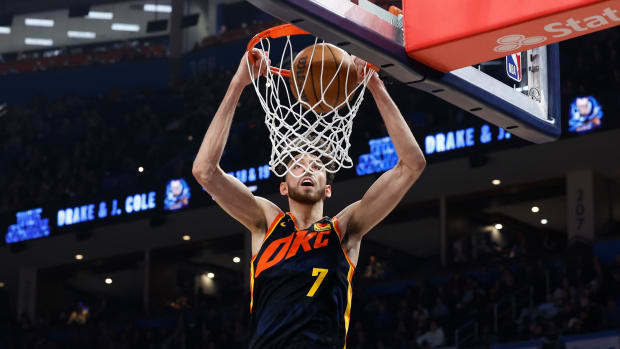The Sixers' Mike Scott Is a Specialist in Every Sense of the Word
There I am, sitting in the lobby of Mike Scott’s Philadelphia apartment building. It has a hotel-type vibe, with a help desk straight ahead and a bar located to the right as you walk in. I patiently wait as residents come down, one by one, to pick up their food deliveries. Then suddenly, Scott appears. He’s wearing relaxed apparel: a Nike hoodie, shorts and a pair of shades. He's just arrived home from a practice session that ran long, as the Sixers had suffered a Game 1 loss to the Brooklyn Nets the day prior.
As we enter the elevator, an older gentleman simultaneously hops on. He stretches his neck upward to get a better view of the 6’8” Scott, and then with no hesitation says, “You must be a tennis player.” Scott glances at me and smirks. Without correcting him, we just chuckled and continued along as the man got off on the next floor.
This came as no surprise to Scott. While he’s easy to spot on the court, with his emoji tattoos and karate-kid headbands, he has only been on Philadelphia’s roster for a few months. He's still getting acclimated to the city. In turn, the city is still familiarizing itself with him.
Of course, Scott is the sixth man on a Sixers team that pushed all its chips to the center of the table in hopes of chasing a championship—or at least get to the Finals, with the Eastern Conference being wide open this season without LeBron James. Scott was included in the deal that brought Tobias Harris from the Clippers. During his brief stint in L.A., Scott served as Harris’s backup, a role he's continued to fill in Philadelphia with no complaints.
“I know I’m good enough to start in the NBA,” he says. “But I know my role. I bring energy, I play tough defense and I space the floor with my shooting. That would be my role whether I’m starting or coming off the bench.”
Scott earns a living knocking down open shots, making smart decisions and giving his team a spark. He’s been a valued addition at every stop he’s made during his seven-year career. And, though the man in the elevator didn’t recognize him, Scott has instantly earned respect throughout Philly—a town well known for its diehard fan base.
“These fans are different,” Scott said. “They show me so much love.”
That love came in abundance after Scott hit the biggest shot of his professional career to seal a win over the Nets in Game 4. Trailing by one with 25 seconds left, Harris tried to lob a pass to Joel Embiid inside the paint. After being corralled by several defenders, Embiid bobbled the entry but found a wide-open Scott, who was spotted up in the left corner. He drained the three—or as he put it, “cashed out”—with 18.6 remaining on the clock, helping his team secure a critical victory and take a commanding 3-1 series lead.
Fourth grade. That’s when Mike Scott moved to Camelot, a neighborhood located in Chesapeake, Va., the same community where I grew up. He stayed with his mom in Washington, D.C., at the time, but she experienced financial difficulties. That caused his dad—who was an officer in the Marines—to make a trip to the nation’s capital to pick up his son.
He compared it to the scene in “Boyz n the Hood” when Reva, played by the great Angela Bassett, dropped off her son, Tre, portrayed by Cuba Gooding Jr., to live with his dad, Furious Styles (Laurence Fishburne).
It was obvious that he would fit right in, because, like everyone else in our area, he was a hooper. That’s literally all we did as kids in the 1990s and early 2000s—play sports. There were no cellphones, the Internet age had yet to take over, and after a while, we’d get tired of playing video games. So we resorted to going outside, in hot or cold weather, to play football, baseball, basketball, you name it.
Then, in 1996, we were blessed with something that changed our lives for the better. The Camelot Community Center was built. “The rec,” as we called it. It was like basketball Heaven. We actually had a place to go after school to stay warm and play ball—whenever we felt like it. Well, until closing time at 9 p.m., that is.
I remember him playing at the rec, on an empty court quietly fine-tuning his game. He was only about nine or 10 years old, but you could tell he was skilled. We wound up playing together at Hugo A. Owens Middle School. He was in the seventh grade; I was in eighth. I was a starter; he barely saw the court. He was about 6-feet tall and talented, but had yet to bring that dog out of him. He was still realizing how good he was capable of being.
But spending time in Camelot, an area that had a strong reputation for its athletes, such as NFL players DeAngelo Hall, Darryl Tapp, James Anderson and Ras-I Dowling, he had no choice but to develop. He entered his freshman year of high school at 6’4” and was beginning to look the part. But even though he had the grades—a 2.0 GPA was needed to be eligible—his dad prevented him from playing because he wanted to see them improved. It wasn’t until the second semester of his sophomore year, after growing to roughly 6’6”, that he began playing basketball at Deep Creek High School. I was a junior at the time and we were again teammates. Our team struggled that year, but Mike played the final two games of the season and instantly made an impact. He scored 22 and 27 points, respectively, and had the town buzzing.
“I saw a kid with a tremendous amount of potential,” said Leroy Ricks, who was in his first full season as our head coach. “He was young, he was tall and he was athletic."
Ricks knew the type of talent he had in Mike. He inserted him into his starting lineup from Day 1 and allowed him to flourish as a player. “He was like a father figure,” Mike said of Ricks. “He reminded me of Coach Carter.”
After a full summer of attending basketball camps and preparing for his junior season, he started to take off. Colleges were put on notice, opposing teams in the area were taking note, and Deep Creek started to garner more attention. He was consistently one of the top scorers in the Tidewater area during his junior and senior seasons and was one of the most highly sought-after players in the state.
He eventually committed to Temple to play for legendary coach John Chaney. But Chaney decided to retire following the 2005-06 season, Mike’s senior year of high school. Instead of making an impulsive decision, he and his dad chose the prep school route for a year. He attended Hargrave Military Academy, located in Chatham, Va.
“It got him going up against top competition on a daily basis,” said Dowling, who was a two-sport athlete at Deep Creek but also attended Hargrave for a year to play football.
That experience helped fill out his game. He had also grown to be a solid 6’8”, and the University of Virginia, an ACC school, was knocking at the door.
To Charlottesville he went. Scott signed a full scholarship to play for Dave Leitao at Virginia. He started 40 games in his first two seasons, but Leitao resigned following a 2008-09 campaign, when the Cavaliers finished 10-18, opening the door for Tony Bennett to step in as head coach.
Virginia failed to reach the 20-win mark in Bennett’s first few seasons. And Scott had yet to experience the NCAA tournament. He was off to a dominant start in 2010-11, his senior year, averaging 15.9 points and 10.2 rebounds as UVA started 7-3, but an ankle injury ended his season and the team again fell short of an NCAA tournament berth.
“He had some ups and downs at UVA starting off,” said Dowling, who played football at Virginia before being drafted by the New England Patriots in 2011. “But he fought through those things and always showed consistency when on the court.”
Scott was given a medical hardship waiver by the ACC, which granted him an extra year of eligibility. He returned stronger and more polished, putting up 18.0 points and 8.3 rebounds per game and being named first-team All-ACC as he led the Cavaliers to their first tournament appearance during his five-year tenure.
But Virginia suffered a disappointing loss to Florida in the first round and Scott’s college career ended. After experiencing how tough it was to get to the tournament, he had a greater appreciation for what Virginia accomplished this season, capturing its first title in school history. “Everything was happening in our favor,” he said. “It was our year.”
The Hawks drafted Scott with the 43rd overall selection in 2012. Larry Drew was the coach at the time, before Mike Budenholzer—now the head coach of the Bucks—took the job over in 2013-14. Scott credits a lot of what he has learned since entering the league to Budenholzer and Kenny Atkinson, who has since moved from Hawks assistant to head coach of the Nets, the Sixers’ first-round opponent.
Budenholzer and his scheme allowed the Hawks to jump atop the East in just his second season with the team (and Scott’s third), as they won a franchise-record 60 games and he earned the Coach of the Year award. Budenholzer implemented an offense in Atlanta that was spearheaded by big men Al Horford and Paul Millsap, both of whom are respectable outside shooters. Scott, who up to that point spent the majority of his career as an inside presence, was forced to expand his game. Under the tutelage of Atkinson and the support of Budenholzer, Scott started to utilize his shooting skills to find a more suitable role in the Hawks’ offense.
“I always had a jumper,” Scott said. “I just never really shot threes.”
He said it started at Virginia when Bennett and assistant Brad Soucie told him he needed to expand his range. But Atkinson, who spent countless hours working with Scott on his jump shot, instilled the confidence he needed to display it on game days. Scott had shot just 44 threes over 130 games at UVA. That carried over to his rookie year, where he took just one in 40 games. That immediately elevated to 200 three-point attempts his second season in the NBA, once Budenholzer and Atkinson took over, and he has since carved out a role as a quintessential stretch four who opposing defenses must respect.
“They told me I wasn’t going to be able to play bully ball in the NBA,” said Scott of Budenholzer and Atkinson. “So I had to get comfortable shooting threes.” Over three of the last four seasons, he has shot over the 39% mark from deep and earned the nickname "Threegional Manager" in the process. But while it’s an area of his game that has drastically improved over the years, it’s not necessarily a role he wants to be recognized for.
“I don’t wanna be known as just a three-point shooter,” Scott said. “There’s more to my game than that.”
His versatility and deceptive athleticism helped get him to the league, but his sweet shooting touch has allowed him to develop a career. He serves well playing next to playmakers, like Embiid, Ben Simmons and Jimmy Butler, who can draw defenders and find open shooters. Simply put, Scott is a perfect paragon for today’s NBA.
“He evolved,” said Ricks, who has kept a close eye on Scott’s progression. “Watching his development from high school to prep school to college, now in his seventh year in the league, I can say he adapted to his surroundings.”
Atlanta is home base. It’s where Scott began his career and where he lives during the offseason. He had plans to be a Hawk for the long haul. But following a Georgia arrest in the summer of 2015—which was eventually dismissed due to racial profiling—and an injury that limited him to 18 games during the 2016-17 season, he was dealt to the Phoenix Suns.
It was a tough stretch for Scott, who bounced back and forth from the G-League, was in a legal battle and was trying to get completely healthy after dealing with injuries to both his knee and ankle.
Then the Suns waived Scott, immediately after acquiring him. That led to him signing a one-year deal with the Washington Wizards. He averaged 8.8 points in 18.5 minutes per game while playing an integral role as Markieff Morris’s backup. But the Wizards didn’t re-sign him in the offseason, despite Scott’s impressive play during their first-round playoff loss to the Raptors. So the Clippers scooped him up on a one-year deal in the summer of 2018.
While he didn’t feel the Clippers had a system that catered to his playing style, his girlfriend and two kids, Jeremiah and Nori, continue to live in L.A. during the season. He explained how much he has matured as a man since becoming a father. “My life changed," he said. "Instead of buying something for myself, I think about buying them things now."
Scott then arrived in Philadelphia, which has been the ideal landing spot. He loves the fans. He loves his coach, Brett Brown. And he loves the talent he’s surrounded with. Most importantly, he’s getting the chance to prolong his career.
When opportunities have presented themselves, whether in high school, college or the NBA, Scott has always taken full advantage. So when the ball dropped in his hands down the stretch in Game 4, he didn’t second-guess himself. It was a moment he’d been waiting for since his Camelot days. He caught it, pulled up and cashed out, making his journey to this point even more worthwhile.
“He’s a fighter,” Dowling said. “If there’s one word to describe him, Mike Scott is resilient.”





































